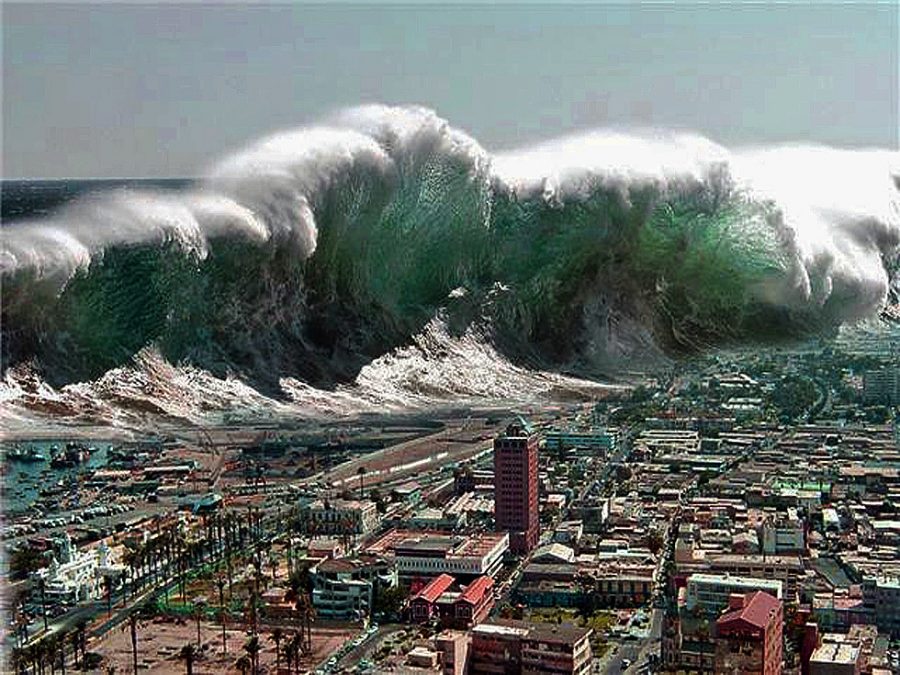Tsunamis
Tsunamis are a series of gigantic sea waves that usually form by underwater earthquakes, volcanic eruptions, meteorites, or underwater landslides. The word “tsunami” is the Japanese word for “harbor wave”. Tsunami waves can travel up to 500 miles an hour while out at sea and when they hit the continental slope near shore typically slow to 20-30 miles an hour. Their waves can have 10 to 100 feet high wave surges. Tsunamis can cause destruction and loss of life. Many tsunamis are caused by underwater earthquakes and the size of the tsunami is determined by the magnitude of the earthquake. It is important to know the warning signs to try and stay safe if you live in an area that may have a tsunami.
There are three different types of tsunamis and the difference between them is distance they have to travel to reach land. The three types are Local Tsunamis, Regional Tsunamis, and Distant Tsunamis. A Local Tsunami travels about 62 miles before it reaches land. A Regional Tsunamis travels about 62 miles to 621 miles before it reaches land. A Distant Tsunamis travels more than 621 miles from land.
Tsunamis mostly happen around the Ring of Fire, which includes the countries of Cambodia, China, Hong Kong, Indonesia, Japan, Korea, Malaysia, Philippines, Singapore, Taiwan, Thailand, and Vietnam. Tsunamis have also been known to happen in Australia, New Zealand, USA, Canada and South America. The third largest recorded and one of the deadliest tsunami was the Indian Tsunami that happened on December 26, 2004. That tsunami had a 9.3 magnitude earthquake and was a Distant Tsunami. Sadly, there were a little more than 230,000 deaths in 14 countries. Indonesia was hit the hardest but Sri Lanka, Thailand and India also suffered a great amount of loss.
There are several different warning signs to let one that a tsunami is coming. One of the signs of a tsunami is that water may retreat from the coast exposing a large piece of the ocean floor. Animals can detect tsunamis before humans, so if you see animals fleeing from the shore line it may be a sign that you need to get to high ground as soon as possible. Another sign may be when you see a wall of water and hear a loud “roaring” sound similar to a train or an aircraft, which is a warning that a tsunami may be on it’s way. The government in many countries will send out an official tsunami warning on the television, radio, and internet.
There are different ways to protect yourself and anyone with you. Just like the fire motto “stop drop, and roll”, the motto for a tsunami is “drop, cover, and hold on” if you are close to the earthquake. When the earthquake stops, go to high ground, away from the ocean. DO NOT wait! Leave as soon as you see any natural signs of a tsunami or receive an official tsunami warning. And if you are in a boat get further out to sea and wait until it is over. The tsunami may be coming within minutes.
There are many hardships that people have to suffer after a tsunami. People have to go through grief and great loss. Animals, as well as humans can drown or be killed by the debris caused during a tsunami. People could be trapped under a piece of building or rubble and there can be massive damage to the community. Many pieces of people’s property are left in the ocean which can lead to pollution. People as well as the community have to pay a lot of money to rebuild the community and some places don’t have much money and sometimes those places can’t rebuild and hope for the best.
There is not a strong rating system for a tsunami but since one cause of a tsunami is an earthquake, the earthquake scale is very important. The rating scale is more for earthquakes. A 2.5 or less rating is usually not felt, but can be recorded by a seismograph. The estimated number of times an earthquake happens each year is 900,000. 2.5 to 5.4 is often felt, but only causes minor damage. The estimated number of times an earthquake happens each year is 30,000. A magnitude of 5.5 to 6.0 means slight damage to buildings and other structures. The estimated number of times an earthquake happens each year is 500. A magnitude of 6.1 to 6.9 may cause a lot of damage in very populated areas. The estimated number of times an earthquake happens each year is 100. A magnitude of 7.0 to 7.9 is a major earthquake. This earthquake causes serious damage and only happens around 20 times a year. A magnitude of 8.0 or greater is what is called a “great earthquake.” These earthquakes can totally demolish communities near the epicenter, witch is the point on the earth’s surface directly above the start of an earthquake. These only happen about once every 5 to 10 years.
In conclusion, there are three different types of tsunamis named for the distance between the epicenter and land. Tsunamis mostly happen around the Ring of Fire. There are a few different warning signs that a tsunami is coming. So be prepared to look out for one. Tsunamis can cause a lot of damage to communities and people’s hearts.
Bibliography
“Search.” National Geographic, National Geographic, www.nationalgeographic.com/search?q=tsunami.
“Tsunamis.” National Geographic, National Geographic, 23 Jan. 2018, www.nationalgeographic.com/environment/natural-disasters/tsunamis/.
“Tsunami.” Earth Facts and Information, www.basicplanet.com/tsunami/.
National Geographic Society. “Tohoku Earthquake and Tsunami.” National Geographic Society, National Geographic, 16 May 2014, www.nationalgeographic.org/thisday/mar11/tohoku-earthquake-and-tsunami/.
“Tsunamis.” Citizen Corps | Ready.gov, www.ready.gov/tsunamis.
“What Are the Natural Warning Signs for a Tsunami?” American Geosciences Institute, 10 Sept. 2017, www.americangeosciences.org/critical-issues/faq/what-are-natural-warning-signs-tsunami.
Rosenberg, Matt. “Tsunami Safety Guide.” Thoughtco., Dotdash, 17 Mar. 2017, www.thoughtco.com/prepare-for-tsunami-1435363.
Endsley, Kevin. “Earthquake Magnitude Scale.” Seismic Education Site: UPSeis, www.geo.mtu.edu/UPSeis/magnitude.html.
“Epicenter.” Wikipedia, Wikimedia Foundation, 2 Feb. 2019, en.wikipedia.org/wiki/Epicenter.
National Geographic Society. “Ring of Fire.” National Geographic Society, National Geographic, 9 Oct. 2012, www.nationalgeographic.org/encyclopedia/ring-fire/.











